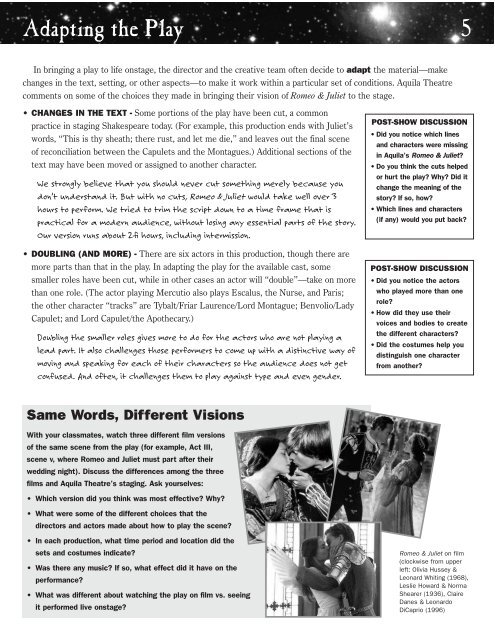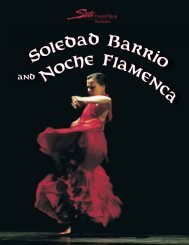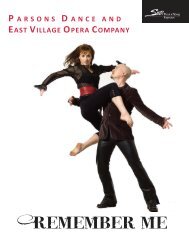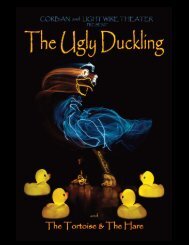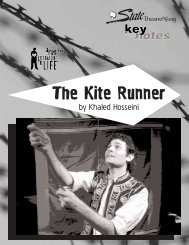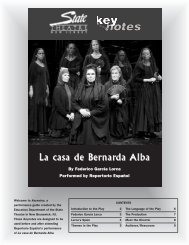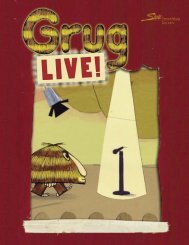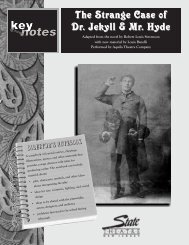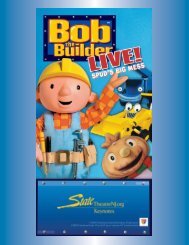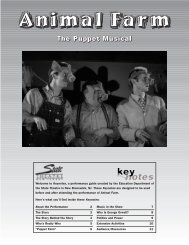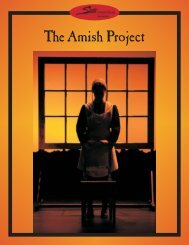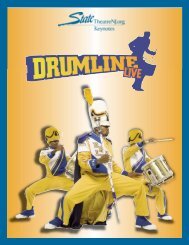The Story 4“For never was a story of more woe / Than this of <strong>Juliet</strong> and her <strong>Romeo</strong>.”Act OneMembers of the rival Capuletand Montague familiesencounter each other in astreet in Verona. They fight.Prince Escalus decrees thatfrom now on, anyone caughtfighting will be put to death.Benvolio tells his uncle, LordMontague, that he will try tofind out what’s been botheringMontague’s son, <strong>Romeo</strong>.<strong>Romeo</strong> tells Benvolio that heis suffering from unrequitedlove for Rosaline.Lord Capulet consents to themarriage of his young daughter<strong>Juliet</strong> with Count Paris—butonly if she is willing. LadyCapulet tells <strong>Juliet</strong> that she willhave a chance to meet Paristhis evening at a party at theirhouse.Mercutio, <strong>Romeo</strong>, and Benvoliocrash the Capulets’ party.Tybalt recognizes <strong>Romeo</strong> but isforced by Capulet to endure hispresence. <strong>Romeo</strong> and <strong>Juliet</strong>dance together, exchangekisses, then discover that theycome from families who aresworn enemies.Act TwoAfter the party, <strong>Romeo</strong> returnsto Capulet’s garden. Mercutioand Benvolio search for him.<strong>Romeo</strong> sees <strong>Juliet</strong> at herbalcony window. They exchangevows of love and plan to marry.<strong>Romeo</strong> visits Friar Laurenceand tells him that he loves<strong>Juliet</strong>. Hoping that their unionwill help end the feud betweentheir families, the Friar agreesto perform the marriageceremony.Mercutio and Benvolio meet upwith <strong>Romeo</strong>. Mercutio and<strong>Romeo</strong> have a battle of wits.The Nurse arrives, looking for<strong>Romeo</strong>. When his friends haveleft, <strong>Romeo</strong> instructs the Nurseto have <strong>Juliet</strong> meet him at FriarLaurence’s to be married.The Nurse returns and tells<strong>Juliet</strong> about the wedding plans.<strong>Juliet</strong> goes to Friar Laurence’scell, where <strong>Romeo</strong> and theFriar are waiting. They go off tobe married.Act ThreeBenvolio and Mercutio meetTybalt in the street. When<strong>Romeo</strong> arrives, he refusesTybalt’s challenge. Mercutiofights Tybalt and is killed. Inrevenge, <strong>Romeo</strong> kills Tybalt,then flees.Waiting in her garden, <strong>Juliet</strong>looks forward to seeing<strong>Romeo</strong>. The Nurse arrives andtells <strong>Juliet</strong> that Tybalt is deadand <strong>Romeo</strong> banished fromVerona for the murder.Back at Friar Laurence’s cell,the Friar tells <strong>Romeo</strong> thatPrince Escalus has sentencedhim to banishment instead ofexecution. The Nurse arrivesand tells <strong>Romeo</strong> to come to<strong>Juliet</strong>’s room that night.Capulet reassures Paris thathis wedding to <strong>Juliet</strong> will takeplace soon, despite the slayingof <strong>Juliet</strong>’s cousin Tybalt.At dawn, <strong>Romeo</strong> leaves <strong>Juliet</strong>’sbedroom. Lady Capulet comesin to inform <strong>Juliet</strong> that she is tobe married to Paris in a fewdays. <strong>Juliet</strong> refuses. Capuletarrives and threatens to disownhis daughter if she does notmarry Paris.Act Four<strong>Juliet</strong> goes to Friar Laurence forhelp and meets Paris. Parisleaves, believing that he and<strong>Juliet</strong> will soon be wed.Friar Laurence gives <strong>Juliet</strong> apotion that will allow her tofake her own death. The Friarwill send a note telling <strong>Romeo</strong>to go to <strong>Juliet</strong>’s funeral cryptand wait for her to awaken. Thetwo can then escape togetherto Mantua.<strong>Juliet</strong> returns home and asksher father for forgiveness,promising to marry Paris. Leftalone, she takes the potionand falls into a stateresembling death. In themorning, the Nurse tries towaken <strong>Juliet</strong> and finds herseemingly dead.Act FiveBenvolio visits <strong>Romeo</strong> in exilein Mantua and tells him that<strong>Juliet</strong> is dead. <strong>Romeo</strong> buyspoison from an apothecary andplans to return to Verona to dieat <strong>Juliet</strong>’s side.The Friar learns that <strong>Romeo</strong>never received his letter tellinghim that <strong>Juliet</strong> is not reallydead. He rushes off to thecemetery, hoping to get therebefore <strong>Romeo</strong>.Paris visits <strong>Juliet</strong>’s grave. When<strong>Romeo</strong> arrives, Parischallenges him and is killed.Believing <strong>Juliet</strong> to be dead,<strong>Romeo</strong> takes the poison. <strong>Juliet</strong>awakens, finds <strong>Romeo</strong> dead,and kills herself.
Adapting the Play 5In bringing a play to life onstage, the director and the creative team often decide to adapt the material—makechanges in the text, setting, or other aspects—to make it work within a particular set of conditions. Aquila <strong>Theatre</strong>comments on some of the choices they made in bringing their vision of <strong>Romeo</strong> & <strong>Juliet</strong> to the stage.• CHANGES IN THE TEXT - Some portions of the play have been cut, a commonpractice in staging Shakespeare today. (For example, this production ends with <strong>Juliet</strong>’swords, “This is thy sheath; there rust, and let me die,” and leaves out the final sceneof reconciliation between the Capulets and the Montagues.) Additional sections of thetext may have been moved or assigned to another character.We strongly believe that you should never cut something merely because youdon’t understand it. But with no cuts, <strong>Romeo</strong> & <strong>Juliet</strong> would take well over 3hours to perform. We tried to trim the script down to a time frame that ispractical for a modern audience, without losing any essential parts of the story.Our version runs about 2fi hours, including intermission.• DOUBLING (AND MORE) - There are six actors in this production, though there aremore parts than that in the play. In adapting the play for the available cast, somesmaller roles have been cut, while in other cases an actor will “double”—take on morethan one role. (The actor playing Mercutio also plays Escalus, the Nurse, and Paris;the other character “tracks” are Tybalt/Friar Laurence/Lord Montague; Benvolio/LadyCapulet; and Lord Capulet/the Apothecary.)Doubling the smaller roles gives more to do for the actors who are not playing alead part. It also challenges those performers to come up with a distinctive way ofmoving and speaking for each of their characters so the audience does not getconfused. And often, it challenges them to play against type and even gender.POST-SHOW DISCUSSION• Did you notice which linesand characters were missingin Aquila’s <strong>Romeo</strong> & <strong>Juliet</strong>?• Do you think the cuts helpedor hurt the play? Why? Did itchange the meaning of thestory? If so, how?• Which lines and characters(if any) would you put back?POST-SHOW DISCUSSION• Did you notice the actorswho played more than onerole?• How did they use theirvoices and bodies to createthe different characters?• Did the costumes help youdistinguish one characterfrom another?Same Words, Different VisionsWith your classmates, watch three different film versionsof the same scene from the play (for example, Act III,scene v, where <strong>Romeo</strong> and <strong>Juliet</strong> must part after theirwedding night). Discuss the differences among the threefilms and Aquila <strong>Theatre</strong>’s staging. Ask yourselves:• Which version did you think was most effective? Why?• What were some of the different choices that thedirectors and actors made about how to play the scene?• In each production, what time period and location did thesets and costumes indicate?• Was there any music? If so, what effect did it have on theperformance?• What was different about watching the play on film vs. seeingit performed live onstage?<strong>Romeo</strong> & <strong>Juliet</strong> on film(clockwise from upperleft: Olivia Hussey &Leonard Whiting (1968),Leslie Howard & NormaShearer (1936), ClaireDanes & LeonardoDiCaprio (1996)


